

Before getting into the details, there are a few necessary background details that need to be understood.
NetBox is the leading solution for modeling and documenting modern networks. By combining the traditional disciplines of IP address management (IPAM) and datacenter infrastructure management (DCIM) with powerful APIs and extensions, NetBox provides the ideal "source of truth" to power network automation. Read on to discover why thousands of organizations worldwide put NetBox at the heart of their infrastructure.
See: https://docs.netbox.dev/en/stable/
Secondly, what is a NetBox plugin?
Plugins are packaged Django apps that can be installed alongside NetBox to provide custom functionality not present in the core application. Plugins can introduce their own models and views, but cannot interfere with existing components. A NetBox user may opt to install plugins provided by the community or build his or her own.
See: https://docs.netbox.dev/en/stable/plugins/
Network documentation and the use of tools like IP Fabric and NetBox are essential components of successful automation initiatives. Properly documenting the network provides invaluable visibility, allowing network administrators to understand device configurations and connections, troubleshoot issues, plan upgrades, and enhance security. Moreover, tools like IP Fabric and NetBox offer structured data that automation scripts rely on, enabling tasks such as configuration management, provisioning, and optimization. This combination of documentation and automation not only reduces manual errors but also accelerates processes, ultimately leading to more efficient and reliable network management.
Many of our valued customers have embraced NetBox as a tool for holding source-of-truth information on their journey towards network automation. What sets IP Fabric apart is its ability to gather an extensive array of network data, making it a perfect companion to NetBox. There are two primary scenarios where synchronizing data from IP Fabric into NetBox proves invaluable. The first scenario is when customers are starting fresh with a NetBox deployment. They're new to the tool and want to enrich it with comprehensive information from their network, which IP Fabric readily provides. The second scenario arises when customers already have an established NetBox instance. In this case, they seek to validate its accuracy against the real network through IP Fabric.
In line with our commitment to enhancing our user experience, we're thrilled to introduce the IP Fabric NetBox Plugin. This innovative plugin is designed to streamline and simplify the process of synchronizing vital network information from IP Fabric directly into NetBox, ensuring that your NetBox instance remains up-to-date and reflective of your actual network infrastructure.
We've made the plugin documentation readily accessible through our public documentation, please see this for installation instructions. With this plugin, users can seamlessly synchronize the following NetBox models:
The NetBox Plugin allows for the configuration of multiple instances of IP Fabric as sources within NetBox. This functionality enables our customers with multiple IP Fabric instances to seamlessly synchronize data, regardless of its source.
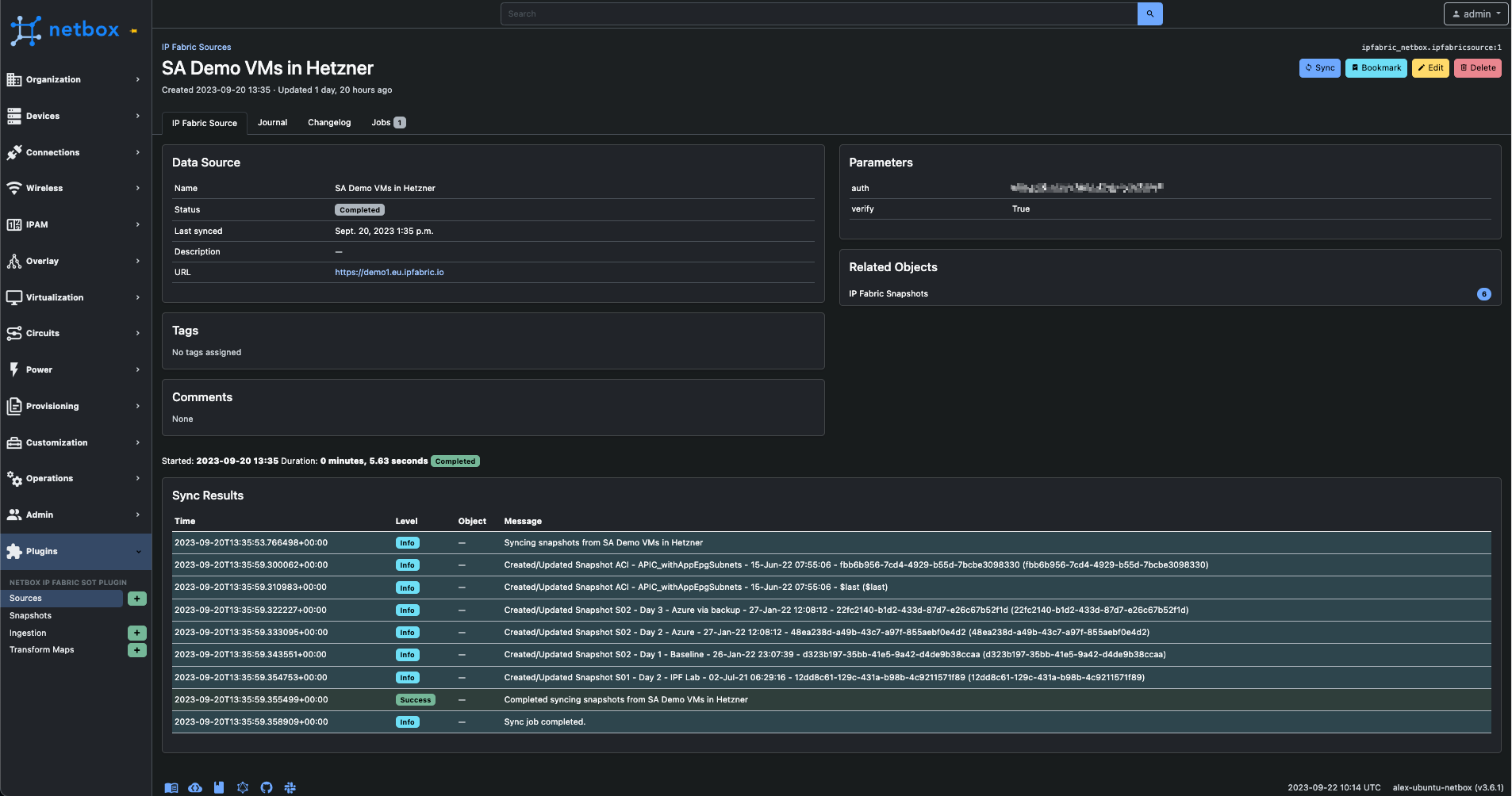
Dividing the process of ingesting snapshot information and network data into two distinct components empowers users to synchronize details about the snapshot IP Fabric, all without the need for real-time connectivity to the IP Fabric API. This approach allows for the seamless presentation of information within NetBox.
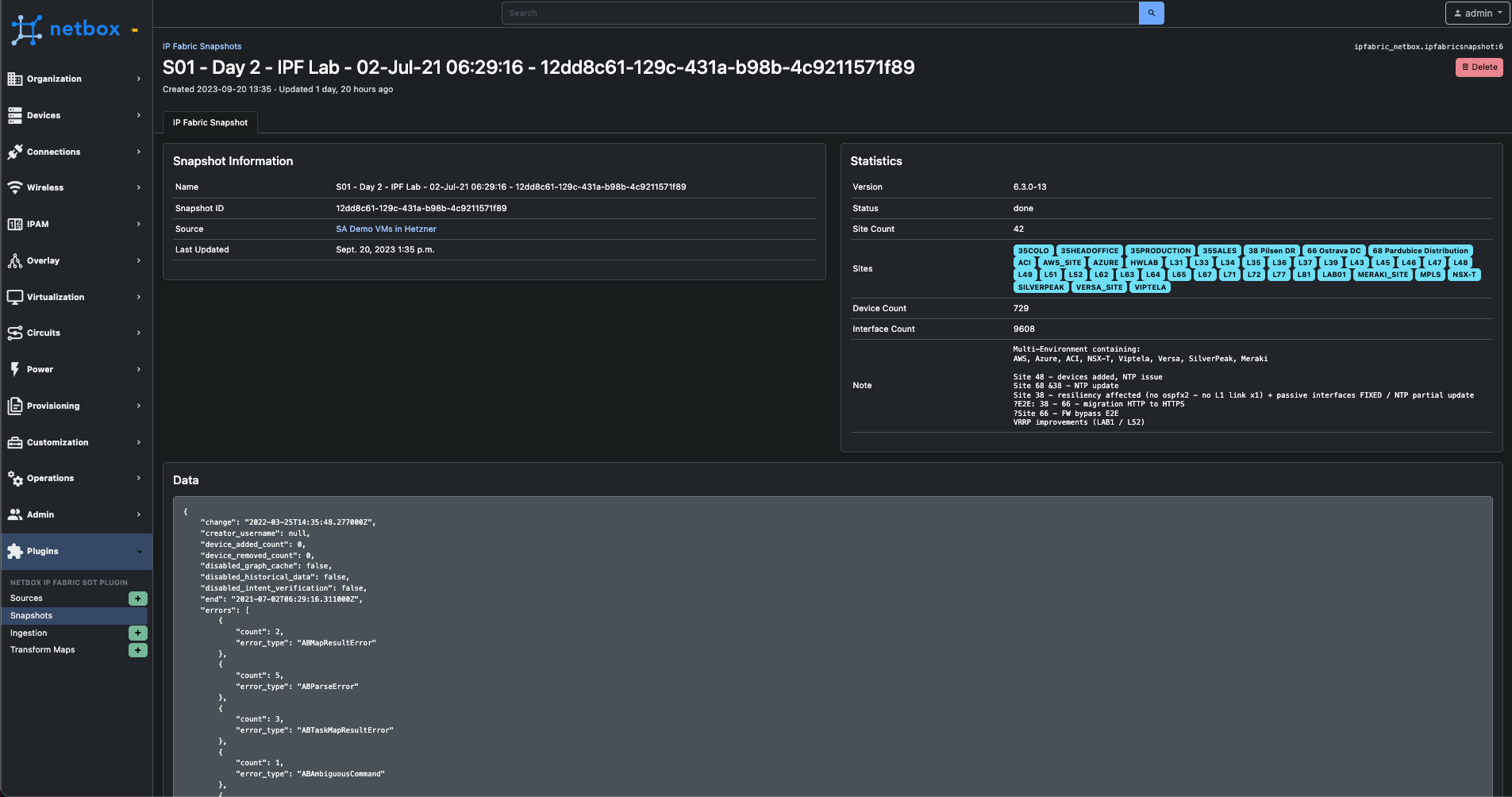
After synchronizing snapshots, an ingestion job can be configured.
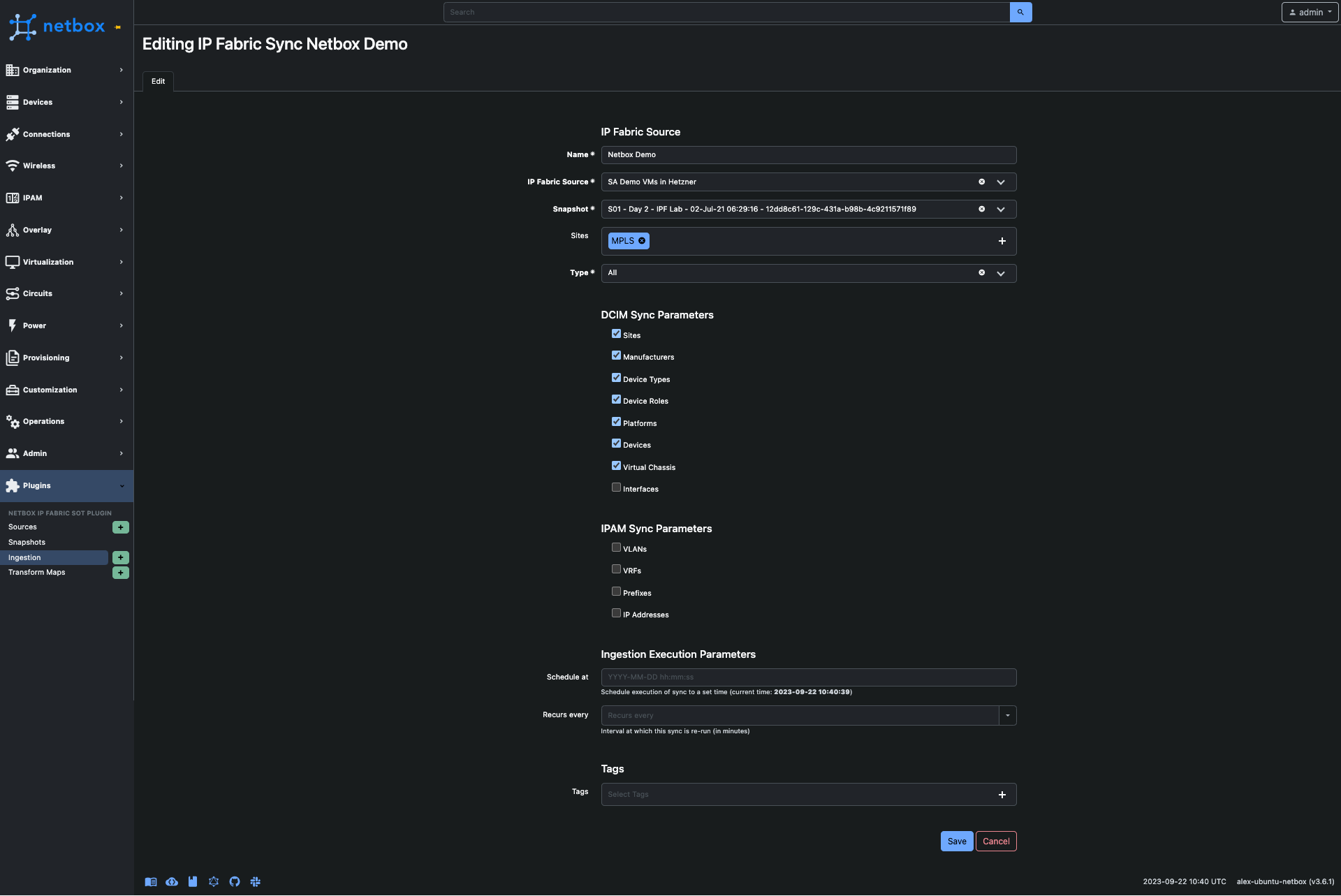
This defines the network information our customers wish to synchronize into NetBox. They can specify the snapshot from which to ingest data, as well as the sites to include. Additionally, customers have the flexibility to choose the models they want to import into NetBox. When selected, the plugin can either update existing models or create new ones in NetBox. When deselected, the plugin will only perform a 'get' operation for the model. Furthermore, customers can schedule these ingestions for future dates or set them to repeat at specific intervals. Any tag associated with an ingestion job will be added to the new models.
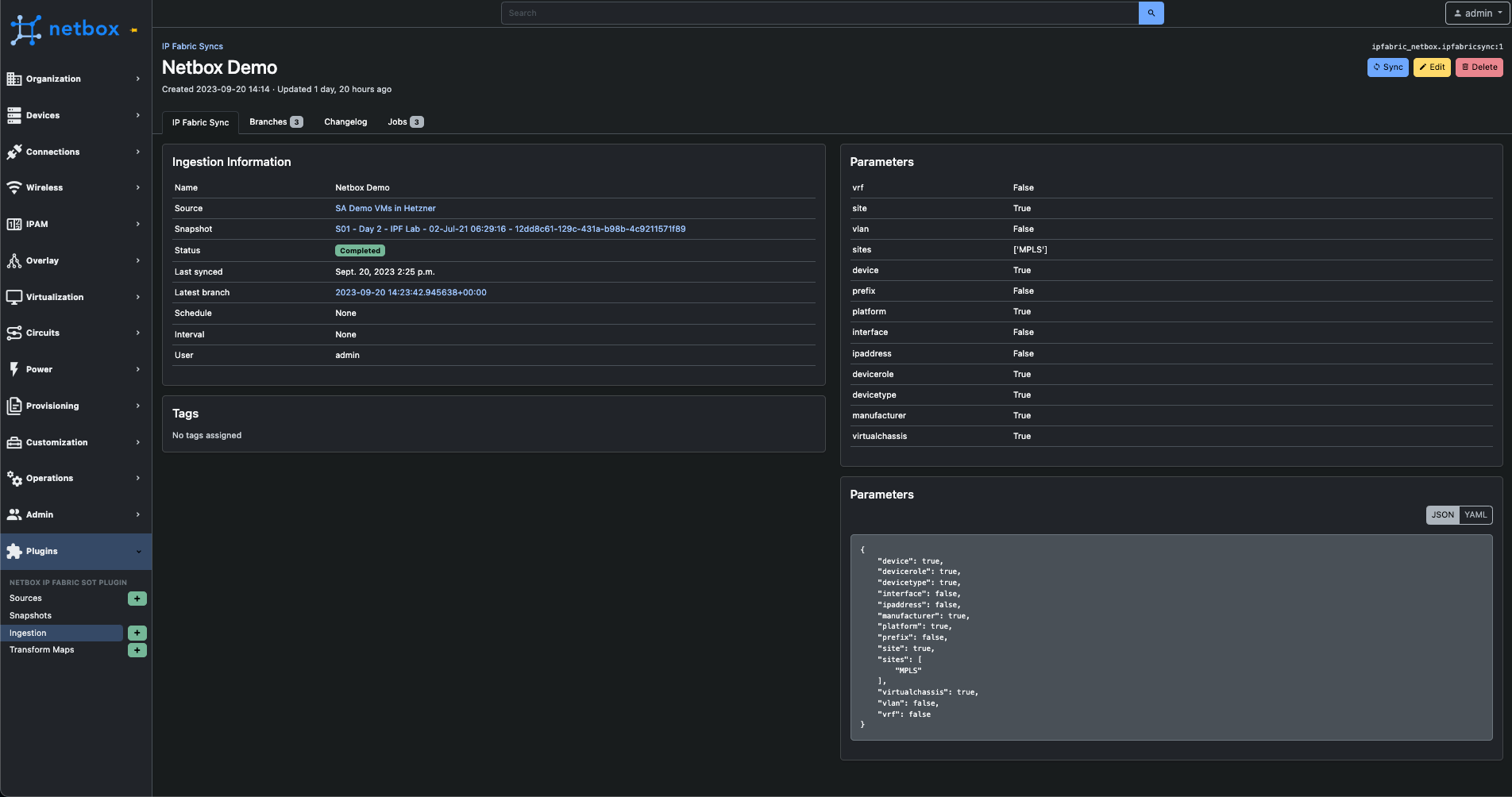
Creating an ingestion job does not imply automatic data synchronization. Instead, the job must be initiated either through a predefined schedule or manually via the 'Sync' button on the ingestion page.
It's important to emphasize that any data ingestion into NetBox does not automatically overwrite existing data. We utilize a feature within NetBox that enables the plugin to propose changes in a branch, akin to how GIT operates. For further details, please refer to the official NetBox documentation.
After initiating a synchronization job, a branch is created where the progress and details of the process can be observed.
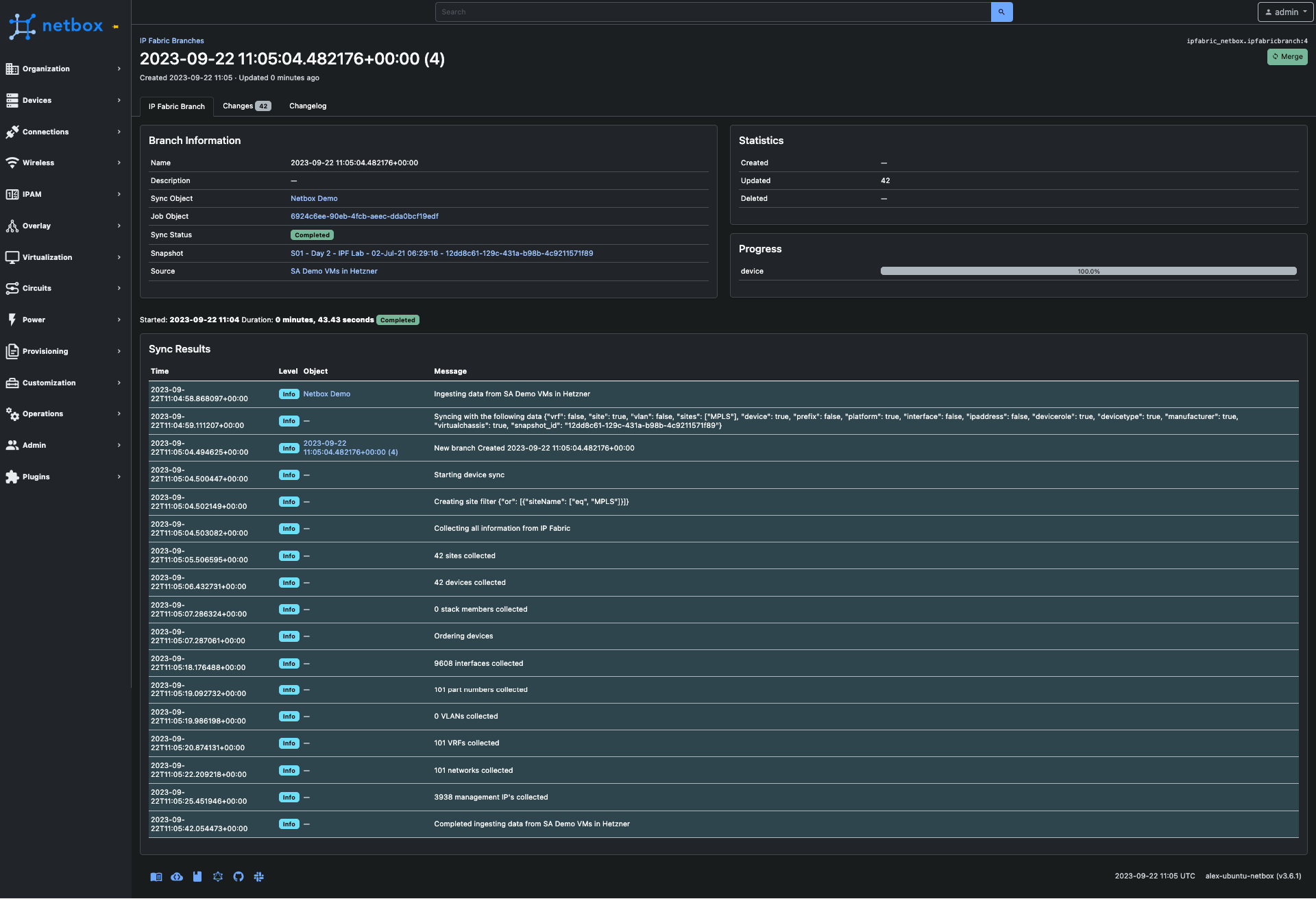
The 'Changes' tab provides information about the modifications that would be applied to the NetBox database if this branch were to be merged.
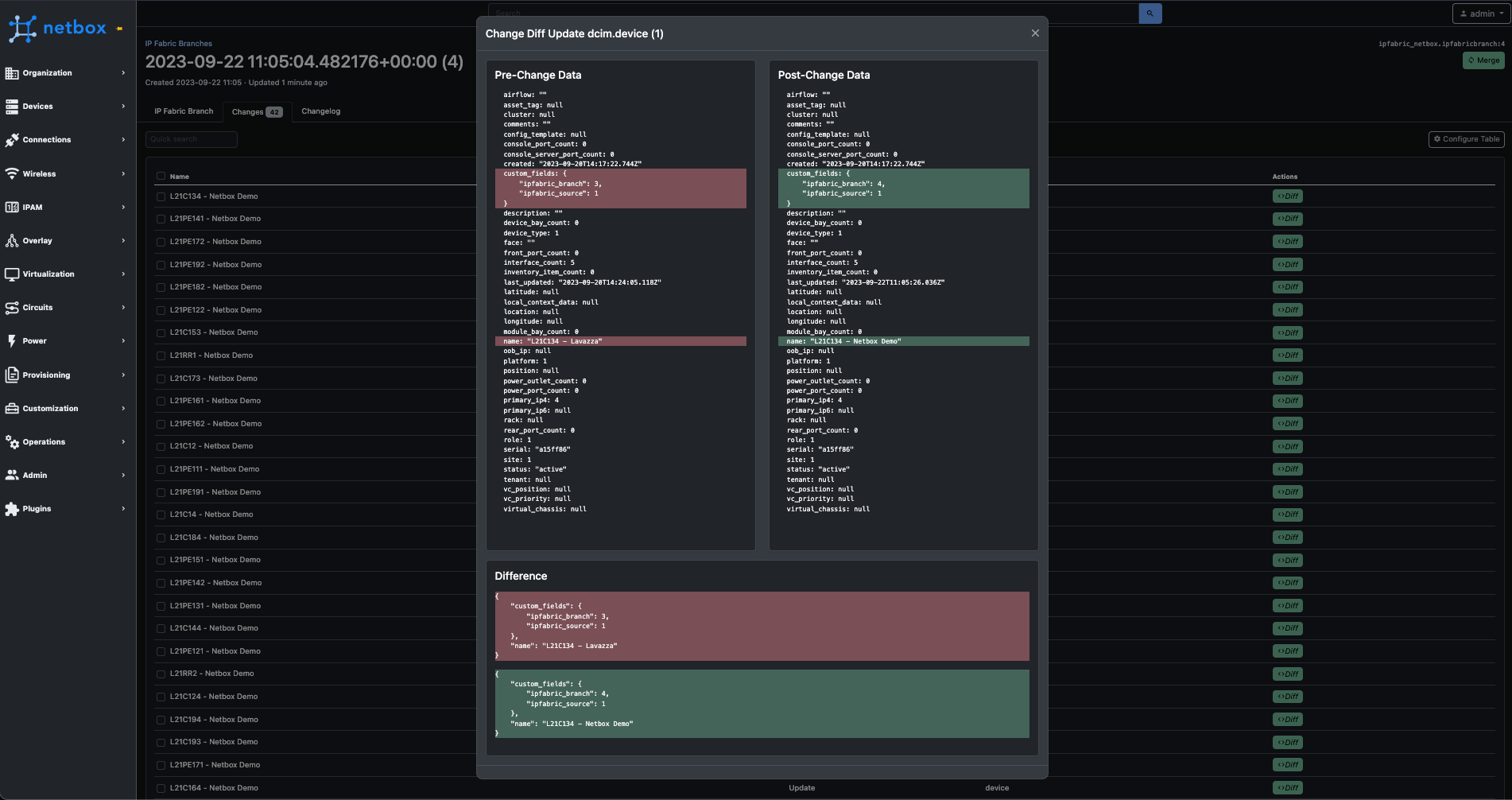
Pretty cool right? I think so. It's important to highlight a key part of the process that makes this work and that is transform maps.
What are transform maps? Transform maps are like a carefully crafted recipe. This recipe serves as a guide, orchestrating the process of extracting data from IP Fabric and delicately depositing it into the appropriate “containers” represented by Django models within NetBox. Its primary objective is to guarantee precise and efficient organization of the data, meticulously tailored to meet your network management requirements. In essence, it acts as a bridge, harmonizing disparate data formats and structures, ensuring a seamless integration of your network data with your NetBox database.
The concept of transform maps is not new; it has been widely employed in various tools for transforming data from one format to another, a practice commonly referred to as ETL (Extract, Transform, Load). This concept draws substantial inspiration from ServiceNow and their implementation of Transform Maps.
During our plugin testing phase with customers, the feedback was overwhelmingly positive. However, a few recurring questions and comments arose, such as, "Can we input data into this specific NetBox field?" or "We don't use NetBox in that manner." These inquiries were primarily linked to the plugin's fixed field structure for various data elements.
The introduction of transform maps proved to be a game-changer. They provided a solution that eliminated the need for custom development for each customer. With transform maps, customers gained the ability to modify our default transform maps to manipulate and designate different data destinations as per their requirements. This newfound flexibility has proven to be a significant advantage, catering to a wider range of customer needs and preferences.
Example with structured data:
The data below is an example of the data used to create a site in Netbox.
{
"siteName": "Site 1",
"devicesCount": 173,
"usersCount": 7075,
"stpDCount": 10,
"switchesCount": 165,
"vlanCount": 113,
"rDCount": 2,
"routersCount": 12,
"networksCount": 77
}The transform map assumes a crucial role in aligning the IP Fabric site table with NetBox's Site model. This synchronization is achieved through the association of transform fields with the transform map. These fields serve as vital connectors, establishing mappings between keys in the dictionary and specific fields within NetBox's database model.
Each transform field possesses two fundamental attributes: a source field (corresponding to a key in the IP Fabric dictionary) and a target field (representing a NetBox model field). These fields sync harmoniously, making it easy to transfer and map data during the ingestion process.
For situations requiring more intricate transformations, the system offers enhanced flexibility. Users can opt to supply a Jinja template, thereby enabling additional functionalities such as slugifying the name of a site or executing supplementary model lookups. This capability empowers the tailoring of the data transformation process to address specific, advanced requirements as necessary.
The following template would result in the siteName being site-1.
{{ object.siteName | slugify }}For more of a detailed explanation on how transform maps work please see our documentation.
If you're an IP Fabric customer using NetBox and haven't been contacted by your solution architect, we encourage you to reach out and express your interest in exploring the NetBox plugin. Should you encounter any challenges or have questions, please don't hesitate to communicate them either directly to your solution architect team or through Gitlab Issues. Your feedback and engagement are valued, and we're here to assist you in making the most of IP Fabric and the NetBox plugin.
Before getting into the details, there are a few necessary background details that need to be understood.
NetBox is the leading solution for modeling and documenting modern networks. By combining the traditional disciplines of IP address management (IPAM) and datacenter infrastructure management (DCIM) with powerful APIs and extensions, NetBox provides the ideal "source of truth" to power network automation. Read on to discover why thousands of organizations worldwide put NetBox at the heart of their infrastructure.
See: https://docs.netbox.dev/en/stable/
Secondly, what is a NetBox plugin?
Plugins are packaged Django apps that can be installed alongside NetBox to provide custom functionality not present in the core application. Plugins can introduce their own models and views, but cannot interfere with existing components. A NetBox user may opt to install plugins provided by the community or build his or her own.
See: https://docs.netbox.dev/en/stable/plugins/
Network documentation and the use of tools like IP Fabric and NetBox are essential components of successful automation initiatives. Properly documenting the network provides invaluable visibility, allowing network administrators to understand device configurations and connections, troubleshoot issues, plan upgrades, and enhance security. Moreover, tools like IP Fabric and NetBox offer structured data that automation scripts rely on, enabling tasks such as configuration management, provisioning, and optimization. This combination of documentation and automation not only reduces manual errors but also accelerates processes, ultimately leading to more efficient and reliable network management.
Many of our valued customers have embraced NetBox as a tool for holding source-of-truth information on their journey towards network automation. What sets IP Fabric apart is its ability to gather an extensive array of network data, making it a perfect companion to NetBox. There are two primary scenarios where synchronizing data from IP Fabric into NetBox proves invaluable. The first scenario is when customers are starting fresh with a NetBox deployment. They're new to the tool and want to enrich it with comprehensive information from their network, which IP Fabric readily provides. The second scenario arises when customers already have an established NetBox instance. In this case, they seek to validate its accuracy against the real network through IP Fabric.
In line with our commitment to enhancing our user experience, we're thrilled to introduce the IP Fabric NetBox Plugin. This innovative plugin is designed to streamline and simplify the process of synchronizing vital network information from IP Fabric directly into NetBox, ensuring that your NetBox instance remains up-to-date and reflective of your actual network infrastructure.
We've made the plugin documentation readily accessible through our public documentation, please see this for installation instructions. With this plugin, users can seamlessly synchronize the following NetBox models:
The NetBox Plugin allows for the configuration of multiple instances of IP Fabric as sources within NetBox. This functionality enables our customers with multiple IP Fabric instances to seamlessly synchronize data, regardless of its source.

Dividing the process of ingesting snapshot information and network data into two distinct components empowers users to synchronize details about the snapshot IP Fabric, all without the need for real-time connectivity to the IP Fabric API. This approach allows for the seamless presentation of information within NetBox.

After synchronizing snapshots, an ingestion job can be configured.

This defines the network information our customers wish to synchronize into NetBox. They can specify the snapshot from which to ingest data, as well as the sites to include. Additionally, customers have the flexibility to choose the models they want to import into NetBox. When selected, the plugin can either update existing models or create new ones in NetBox. When deselected, the plugin will only perform a 'get' operation for the model. Furthermore, customers can schedule these ingestions for future dates or set them to repeat at specific intervals. Any tag associated with an ingestion job will be added to the new models.

Creating an ingestion job does not imply automatic data synchronization. Instead, the job must be initiated either through a predefined schedule or manually via the 'Sync' button on the ingestion page.
It's important to emphasize that any data ingestion into NetBox does not automatically overwrite existing data. We utilize a feature within NetBox that enables the plugin to propose changes in a branch, akin to how GIT operates. For further details, please refer to the official NetBox documentation.
After initiating a synchronization job, a branch is created where the progress and details of the process can be observed.

The 'Changes' tab provides information about the modifications that would be applied to the NetBox database if this branch were to be merged.

Pretty cool right? I think so. It's important to highlight a key part of the process that makes this work and that is transform maps.
What are transform maps? Transform maps are like a carefully crafted recipe. This recipe serves as a guide, orchestrating the process of extracting data from IP Fabric and delicately depositing it into the appropriate “containers” represented by Django models within NetBox. Its primary objective is to guarantee precise and efficient organization of the data, meticulously tailored to meet your network management requirements. In essence, it acts as a bridge, harmonizing disparate data formats and structures, ensuring a seamless integration of your network data with your NetBox database.
The concept of transform maps is not new; it has been widely employed in various tools for transforming data from one format to another, a practice commonly referred to as ETL (Extract, Transform, Load). This concept draws substantial inspiration from ServiceNow and their implementation of Transform Maps.
During our plugin testing phase with customers, the feedback was overwhelmingly positive. However, a few recurring questions and comments arose, such as, "Can we input data into this specific NetBox field?" or "We don't use NetBox in that manner." These inquiries were primarily linked to the plugin's fixed field structure for various data elements.
The introduction of transform maps proved to be a game-changer. They provided a solution that eliminated the need for custom development for each customer. With transform maps, customers gained the ability to modify our default transform maps to manipulate and designate different data destinations as per their requirements. This newfound flexibility has proven to be a significant advantage, catering to a wider range of customer needs and preferences.
Example with structured data:
The data below is an example of the data used to create a site in Netbox.
{
"siteName": "Site 1",
"devicesCount": 173,
"usersCount": 7075,
"stpDCount": 10,
"switchesCount": 165,
"vlanCount": 113,
"rDCount": 2,
"routersCount": 12,
"networksCount": 77
}The transform map assumes a crucial role in aligning the IP Fabric site table with NetBox's Site model. This synchronization is achieved through the association of transform fields with the transform map. These fields serve as vital connectors, establishing mappings between keys in the dictionary and specific fields within NetBox's database model.
Each transform field possesses two fundamental attributes: a source field (corresponding to a key in the IP Fabric dictionary) and a target field (representing a NetBox model field). These fields sync harmoniously, making it easy to transfer and map data during the ingestion process.
For situations requiring more intricate transformations, the system offers enhanced flexibility. Users can opt to supply a Jinja template, thereby enabling additional functionalities such as slugifying the name of a site or executing supplementary model lookups. This capability empowers the tailoring of the data transformation process to address specific, advanced requirements as necessary.
The following template would result in the siteName being site-1.
{{ object.siteName | slugify }}For more of a detailed explanation on how transform maps work please see our documentation.
If you're an IP Fabric customer using NetBox and haven't been contacted by your solution architect, we encourage you to reach out and express your interest in exploring the NetBox plugin. Should you encounter any challenges or have questions, please don't hesitate to communicate them either directly to your solution architect team or through Gitlab Issues. Your feedback and engagement are valued, and we're here to assist you in making the most of IP Fabric and the NetBox plugin.




